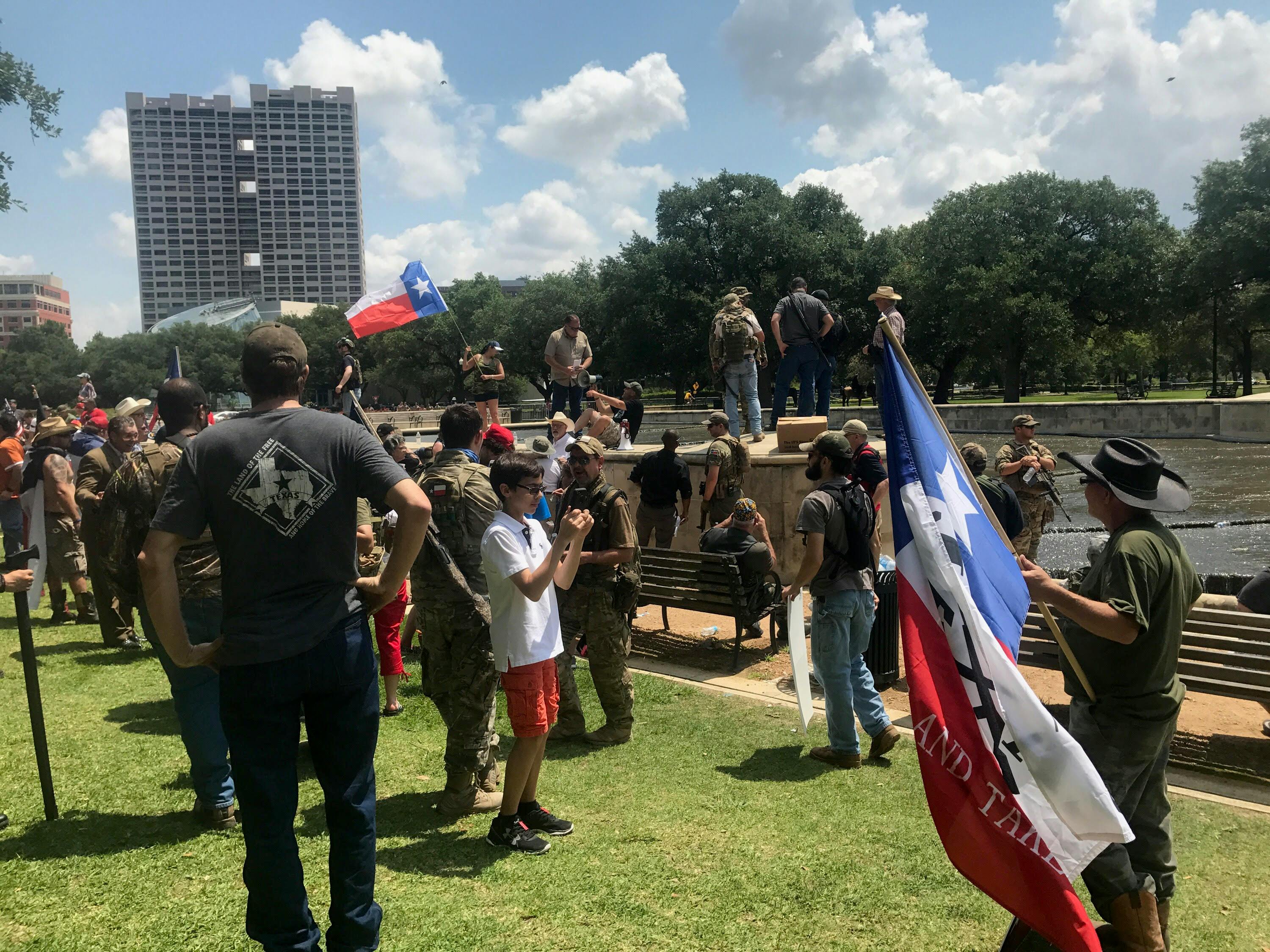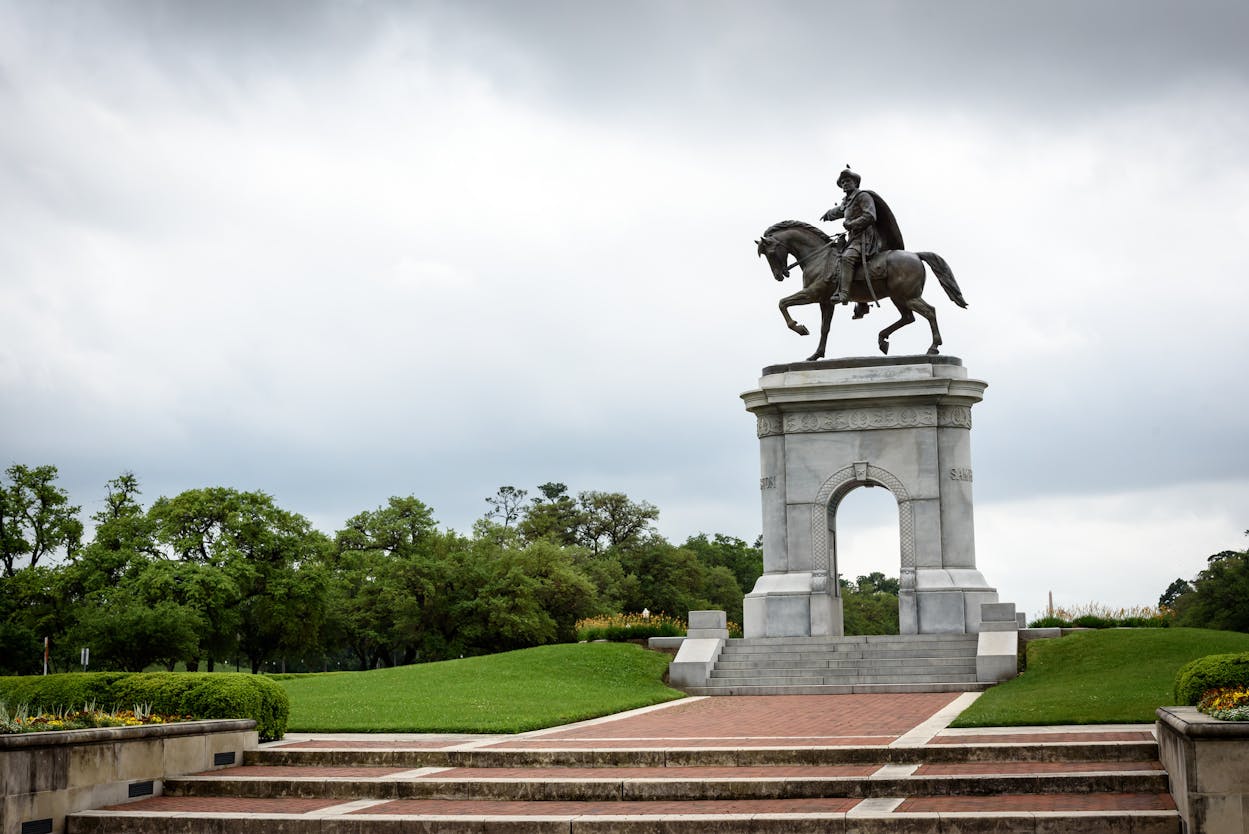The head-spinning Battle of Sam Houston’s Statue is over, culminating in a media circus that was ultimately birthed from a troll job. And that’s exactly what many believed it to be all along.
To rewind, a group calling itself “Texas Antifa” (“antifa” is short for anti-fascists) posted on Facebook a few months ago that their group wanted to topple the statue of Sam Houston that stands at the northern entrance to Houston’s Hermann Park. From there, they would plot to smash the massive Sam Houston statue standing guard along I-45 in Huntsville into gravel. Finally, they would rename the Sam Houston National Forest. And why would these group of people purporting to be liberals target ol’ Sam? “Texas Antifa” claimed to make these demands because Houston had been a slaveholder.
All of this was a lie.
Accepting this Facebook group as a legitimate leftist group, at least two prominent Houston media outlets fed the trolls. Glenn Beck’s website weighed in, and even after the Houston Press called out the threat to the statue as a false flag attack, about 1,000 people showed up to Hermann Park on Saturday—many of them armed with long guns—to protect the statue from nonexistent anti-fascist protesters.
Many of those had been exhorted to do so by a rightist Facebook group This Is Texas. The group organized a counter protest in order to stop “communist punks,” Black Panthers, and anti-fascists who were “embolden [sic] after they lay claim to a win in New Orleans by bringing down the Confederate monuments.” The event description continued: “They have made threats toward Texas & Texans saying ‘Texans better not show up or they will limp home bruised, broken, hurt, with their tail between their legs’ & ‘Smash the state’.”
Again, this alleged threat was all a prank.
Even before it was unequivocally revealed to be a troll job—a group claiming affiliation to the hacktivitist collective Anonymous has since claimed credit for the Texas Antifa page—that fact was readily apparent on the ground at the park on Saturday. The traffic circle around the equestrian statue was cordoned off with police tape, an area that a cop on the scene told me was supposed to have been reserved for the anti-Sam crowd. And there, ready to take action against the statue, was, well, nobody. Not a soul.
Meanwhile, there was a large “counter-protest” outside of the traffic circle. Hundreds of folks in camouflage or Army uniforms (many with Texas insignia instead of American; as the father of an active-duty American soldier, I can easily tell the difference), and leather gear affiliated with various motorcycle clubs. Some were waving “Come and Take It” and “Don’t Tread On Me” flags, and many of them were openly carrying weapons, ranging from shotguns to replica Winchesters to bolt-action rifles to AR-15s.
A police chopper buzzed overhead as dozens of cops, some on foot and some on horseback, were at attention. A mass casualty paramedic truck was parked nearby. The expense to Houston taxpayers must have been considerable, and that extra police presence, the hundreds of armed men, and the constant whine of the chopper’s rotors did not make for a peaceful Saturday in the park for anyone who happened to stumble upon the scene.
It is, of course, impossible to prove, but I would wager that precious few of the “counter-protestors” were typical patrons of Hermann Park, or anywhere in Houston, really. I have never seen so many pro-Confederate bumper stickers on as many cars as I did in the parking lot, nor as much Texas secessionist sentiment. Even before Dylann Roof’s massacre, Houston was quietly shelving its Dixie regalia, and that process has only accelerated since that awful event.
Some of the counter-protestors seemed to take their mere presence as a victory. One man told a group of reporters that their group had won the day because they had showed up and the protestors—referring to the fake “Texas Antifa” group—had not. Voices in the crowd had it that the leftists had chickened out due to the superior firepower, alleged moral high ground, or more ardent patriotism of this group. (Some of those who claimed victory for this glorious triumph were outraged when the Anonymous group revealed that the whole thing had been a hoax and that groups like Antifa, the Black Panthers, and Black Lives Matter never had any intention of attending.)

Another man who identified himself as Jansen, an assault rifle strapped over his shoulder, pointed to the statue of Sam Houston as he said, “This is our history and it will not move.” Indeed, the history of the statue is important to note. The very statue the counter-protestors were “protecting” was controversial when it was built, but not for the reasons that many of the group might recall.
In the August 1927 issue of H.L. Mencken’s American Mercury magazine, native Texan Sam H. Acheson penned an article about the unveiling of this very same Sam Houston statue. Why did it take the city of Houston almost one hundred years to erect a monument to its founder? After all, the statue of Confederate commander Dick Dowling, which stands at the Cambridge Street entrance to Hermann Park, was honored with Houston’s first public monument in 1905. It once presided over Houston’s central plaza near old city hall, but has since been moved twice. Simply put, the old Houstonian elite regarded the hero of San Jacinto as a traitor, because he chose the Union over the Confederacy. “[And] for that he has never been forgiven,” Acheson wrote.
Houston loathed the Confederacy. He called Confederate president Jefferson Davis “as ambitious as Lucifer and as cold as a lizard,” and on the eve of the Civil War, he had this to say:
“It has been my misfortune to peril my all for the Union. So indissolubly connected is my life, my history, my hopes, my fortunes, with it, that when it falls, I would ask that with it might close my career, that I might not survive the destruction of the shrine that I had been taught to regard as holy and inviolate, since my boyhood. I have beheld it, the fairest fabric of Government God ever vouchsafed to man, more than a half century. May it never be my fate to stand sadly gazing on its ruins! To be deprived of it, after enjoying it so long, would be a calamity, such as no people yet have endured.”
Three years later, as the war was still raging, a Presbyterian minister gave Houston one last chance to repent his “sin” of Unionism. “My views as to the propriety and possibility of success of this wicked revolution have undergone no change,” Houston told the preacher. Houston died within an hour.
All of which makes him a highly unlikely hero of modern-day secessionist types, but that didn’t stop them from rallying around Old Sam—a man who would have despised their views—in response to a sham threat to tear his likeness down. After all, much of this backlash came from actions in Louisiana, where several Confederate statues were removed in New Orleans. Noting his strong opposition, it’s hard to believe Houston would have had the same reaction as fake Texas Antifa/Anonymous. As they explained after revealing their ruse:
Statues, for the most part, are how we honor those who worked so hard to give us what we have today. Only those of little accomplishment who have no respect for the past would wish these monuments to be gone. Only a State that has no regard for history would fail to immediately pass a sweeping law [HB 1359] protecting them in light of the recent actions in Louisiana.
A sweeping law to protect Confederate monuments? With that law’s supporter’s rallying around a statue of Sam Houston in his own namesake city, some of them openly displaying secessionist insignia? Sam Houston might have wept.







